1.15: Ángulos suplementarios
- Page ID
- 107652
\( \newcommand{\vecs}[1]{\overset { \scriptstyle \rightharpoonup} {\mathbf{#1}} } \)
\( \newcommand{\vecd}[1]{\overset{-\!-\!\rightharpoonup}{\vphantom{a}\smash {#1}}} \)
\( \newcommand{\dsum}{\displaystyle\sum\limits} \)
\( \newcommand{\dint}{\displaystyle\int\limits} \)
\( \newcommand{\dlim}{\displaystyle\lim\limits} \)
\( \newcommand{\id}{\mathrm{id}}\) \( \newcommand{\Span}{\mathrm{span}}\)
( \newcommand{\kernel}{\mathrm{null}\,}\) \( \newcommand{\range}{\mathrm{range}\,}\)
\( \newcommand{\RealPart}{\mathrm{Re}}\) \( \newcommand{\ImaginaryPart}{\mathrm{Im}}\)
\( \newcommand{\Argument}{\mathrm{Arg}}\) \( \newcommand{\norm}[1]{\| #1 \|}\)
\( \newcommand{\inner}[2]{\langle #1, #2 \rangle}\)
\( \newcommand{\Span}{\mathrm{span}}\)
\( \newcommand{\id}{\mathrm{id}}\)
\( \newcommand{\Span}{\mathrm{span}}\)
\( \newcommand{\kernel}{\mathrm{null}\,}\)
\( \newcommand{\range}{\mathrm{range}\,}\)
\( \newcommand{\RealPart}{\mathrm{Re}}\)
\( \newcommand{\ImaginaryPart}{\mathrm{Im}}\)
\( \newcommand{\Argument}{\mathrm{Arg}}\)
\( \newcommand{\norm}[1]{\| #1 \|}\)
\( \newcommand{\inner}[2]{\langle #1, #2 \rangle}\)
\( \newcommand{\Span}{\mathrm{span}}\) \( \newcommand{\AA}{\unicode[.8,0]{x212B}}\)
\( \newcommand{\vectorA}[1]{\vec{#1}} % arrow\)
\( \newcommand{\vectorAt}[1]{\vec{\text{#1}}} % arrow\)
\( \newcommand{\vectorB}[1]{\overset { \scriptstyle \rightharpoonup} {\mathbf{#1}} } \)
\( \newcommand{\vectorC}[1]{\textbf{#1}} \)
\( \newcommand{\vectorD}[1]{\overrightarrow{#1}} \)
\( \newcommand{\vectorDt}[1]{\overrightarrow{\text{#1}}} \)
\( \newcommand{\vectE}[1]{\overset{-\!-\!\rightharpoonup}{\vphantom{a}\smash{\mathbf {#1}}}} \)
\( \newcommand{\vecs}[1]{\overset { \scriptstyle \rightharpoonup} {\mathbf{#1}} } \)
\( \newcommand{\vecd}[1]{\overset{-\!-\!\rightharpoonup}{\vphantom{a}\smash {#1}}} \)
\(\newcommand{\avec}{\mathbf a}\) \(\newcommand{\bvec}{\mathbf b}\) \(\newcommand{\cvec}{\mathbf c}\) \(\newcommand{\dvec}{\mathbf d}\) \(\newcommand{\dtil}{\widetilde{\mathbf d}}\) \(\newcommand{\evec}{\mathbf e}\) \(\newcommand{\fvec}{\mathbf f}\) \(\newcommand{\nvec}{\mathbf n}\) \(\newcommand{\pvec}{\mathbf p}\) \(\newcommand{\qvec}{\mathbf q}\) \(\newcommand{\svec}{\mathbf s}\) \(\newcommand{\tvec}{\mathbf t}\) \(\newcommand{\uvec}{\mathbf u}\) \(\newcommand{\vvec}{\mathbf v}\) \(\newcommand{\wvec}{\mathbf w}\) \(\newcommand{\xvec}{\mathbf x}\) \(\newcommand{\yvec}{\mathbf y}\) \(\newcommand{\zvec}{\mathbf z}\) \(\newcommand{\rvec}{\mathbf r}\) \(\newcommand{\mvec}{\mathbf m}\) \(\newcommand{\zerovec}{\mathbf 0}\) \(\newcommand{\onevec}{\mathbf 1}\) \(\newcommand{\real}{\mathbb R}\) \(\newcommand{\twovec}[2]{\left[\begin{array}{r}#1 \\ #2 \end{array}\right]}\) \(\newcommand{\ctwovec}[2]{\left[\begin{array}{c}#1 \\ #2 \end{array}\right]}\) \(\newcommand{\threevec}[3]{\left[\begin{array}{r}#1 \\ #2 \\ #3 \end{array}\right]}\) \(\newcommand{\cthreevec}[3]{\left[\begin{array}{c}#1 \\ #2 \\ #3 \end{array}\right]}\) \(\newcommand{\fourvec}[4]{\left[\begin{array}{r}#1 \\ #2 \\ #3 \\ #4 \end{array}\right]}\) \(\newcommand{\cfourvec}[4]{\left[\begin{array}{c}#1 \\ #2 \\ #3 \\ #4 \end{array}\right]}\) \(\newcommand{\fivevec}[5]{\left[\begin{array}{r}#1 \\ #2 \\ #3 \\ #4 \\ #5 \\ \end{array}\right]}\) \(\newcommand{\cfivevec}[5]{\left[\begin{array}{c}#1 \\ #2 \\ #3 \\ #4 \\ #5 \\ \end{array}\right]}\) \(\newcommand{\mattwo}[4]{\left[\begin{array}{rr}#1 \amp #2 \\ #3 \amp #4 \\ \end{array}\right]}\) \(\newcommand{\laspan}[1]{\text{Span}\{#1\}}\) \(\newcommand{\bcal}{\cal B}\) \(\newcommand{\ccal}{\cal C}\) \(\newcommand{\scal}{\cal S}\) \(\newcommand{\wcal}{\cal W}\) \(\newcommand{\ecal}{\cal E}\) \(\newcommand{\coords}[2]{\left\{#1\right\}_{#2}}\) \(\newcommand{\gray}[1]{\color{gray}{#1}}\) \(\newcommand{\lgray}[1]{\color{lightgray}{#1}}\) \(\newcommand{\rank}{\operatorname{rank}}\) \(\newcommand{\row}{\text{Row}}\) \(\newcommand{\col}{\text{Col}}\) \(\renewcommand{\row}{\text{Row}}\) \(\newcommand{\nul}{\text{Nul}}\) \(\newcommand{\var}{\text{Var}}\) \(\newcommand{\corr}{\text{corr}}\) \(\newcommand{\len}[1]{\left|#1\right|}\) \(\newcommand{\bbar}{\overline{\bvec}}\) \(\newcommand{\bhat}{\widehat{\bvec}}\) \(\newcommand{\bperp}{\bvec^\perp}\) \(\newcommand{\xhat}{\widehat{\xvec}}\) \(\newcommand{\vhat}{\widehat{\vvec}}\) \(\newcommand{\uhat}{\widehat{\uvec}}\) \(\newcommand{\what}{\widehat{\wvec}}\) \(\newcommand{\Sighat}{\widehat{\Sigma}}\) \(\newcommand{\lt}{<}\) \(\newcommand{\gt}{>}\) \(\newcommand{\amp}{&}\) \(\definecolor{fillinmathshade}{gray}{0.9}\)Dos ángulos que suman 180 grados y cuando son adyacentes forman una línea recta.
Pares Lineales
Dos ángulos son adyacentes si tienen el mismo vértice, comparten un lado y no se superponen. \(\angle PSQ\)y\(\angle QSR\) son adyacentes.
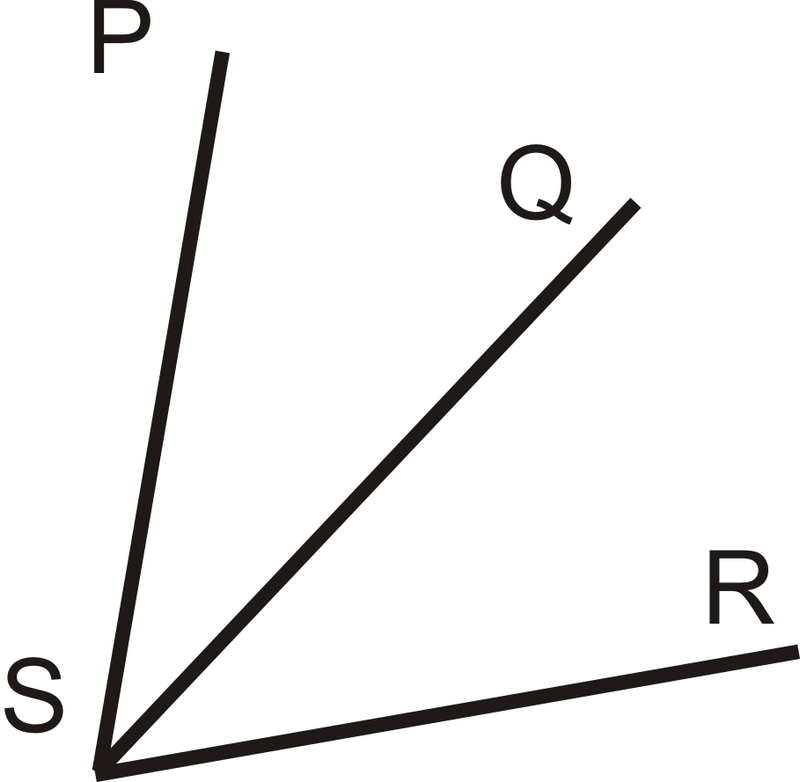 Figura\(\PageIndex{1}\)
Figura\(\PageIndex{1}\)Un par lineal es dos ángulos que son adyacentes y cuyos lados no comunes forman una línea recta. Si dos ángulos son un par lineal, entonces son complementarios (suman\(180^{\circ}\)). \(\angle PSQ\)y\(\angle QSR\) son un par lineal.
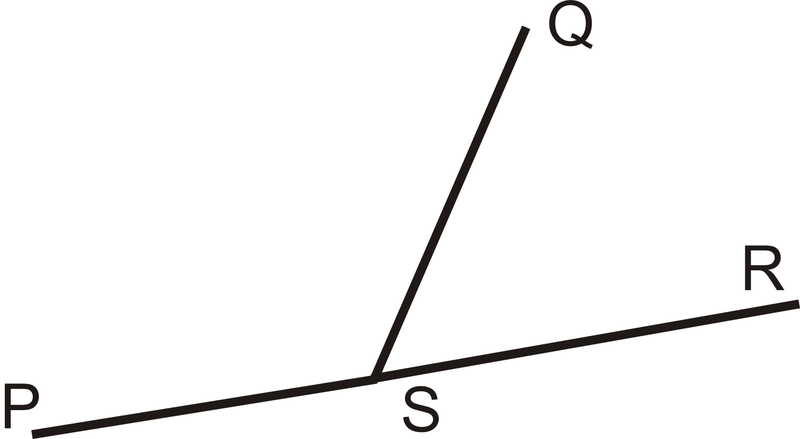 Figura\(\PageIndex{2}\)
Figura\(\PageIndex{2}\)¿Y si te dieran dos ángulos de tamaño desconocido y te dijeran que forman un par lineal? ¿Cómo determinarías sus medidas de ángulo?
Por ejemplo\(\PageIndex{1}\) y\(\PageIndex{2}\), usa el diagrama a continuación. Tenga en cuenta que\(\overline{NK} \perp \overleftrightarrow{IL}\).
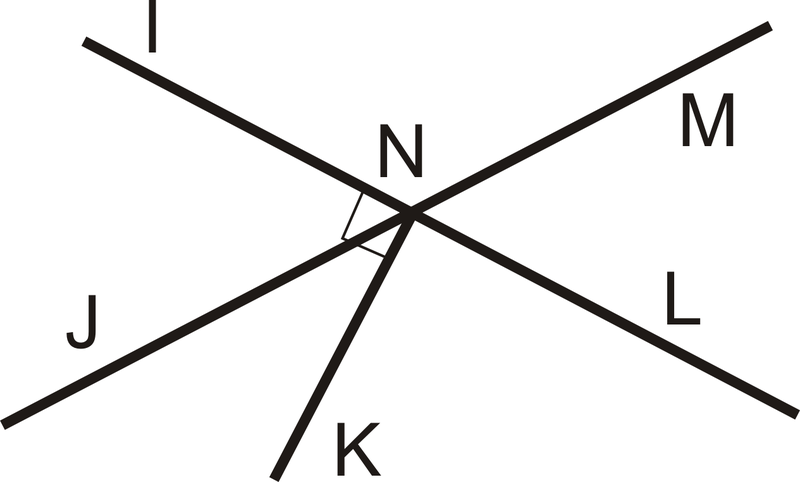 Figura\(\PageIndex{3}\)
Figura\(\PageIndex{3}\)Ejemplo\(\PageIndex{1}\)
Nombra un par lineal de ángulos.
Solución
\(\angle MNL\)y\(\angle LNJ\)
Ejemplo\(\PageIndex{2}\)
¿Qué es\(m \angle INL\)?
Solución
\(180^{\circ}\)
Ejemplo\(\PageIndex{3}\)
¿Cuál es la medida de cada ángulo?
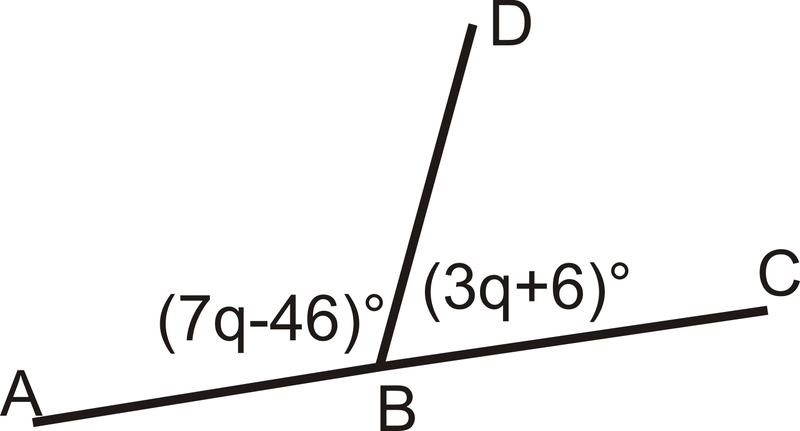 Figura\(\PageIndex{4}\)
Figura\(\PageIndex{4}\)Solución
Estos dos ángulos son un par lineal, por lo que suman\(180^{\circ}\).
\((7q−46)^{\circ}+(3q+6)^{\circ}=180^{\circ}\)
\(10q−40^{\circ}=220^{\circ}\)
\(10q=180^{\circ}\)
\(q=22^{\circ}\)
Enchufe q para obtener la medida de cada ángulo.
\(m \angle ABD=7(22^{\circ})−46^{\circ}=108^{\circ} \)
\(m \angle DBC=180^{\circ}−108^{\circ}=72^{\circ}\)
Ejemplo\(\PageIndex{4}\)
¿Son\(\angle CDA\) y\(\angle DAB\) un par lineal? ¿Son complementarios?
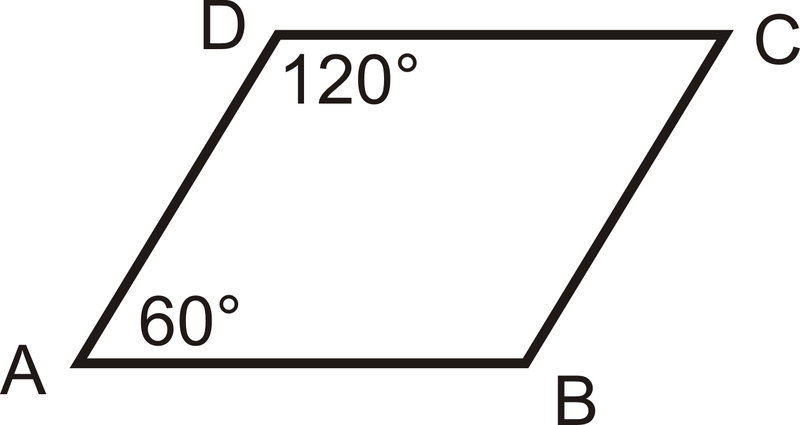 Figura\(\PageIndex{5}\)
Figura\(\PageIndex{5}\)Solución
Los dos ángulos no son un par lineal porque no tienen el mismo vértice. Son complementarios porque suman\(180^{\circ}: 120^{\circ}+60^{\circ}=180^{\circ}\).
Ejemplo\(\PageIndex{5}\)
Encuentra la medida de un ángulo que forma un par lineal con\(\angle MRS\) si\(m \angle MRS\) es\(150^{\circ}\).
Solución
Debido a que los pares lineales tienen que sumar\(180^{\circ}\), el otro ángulo debe ser\(180^{\circ}−150^{\circ}=30^{\circ}\).
Revisar
Para 1-5, determinar si la declaración es verdadera o falsa.
- Los pares lineales son congruentes.
- Los ángulos adyacentes comparten un vértice.
- Los ángulos adyacentes se superponen.
- Los pares lineales son suplementarios.
- Los ángulos suplementarios forman pares lineales.
Para el ejercicio 6, encuentra el valor de\(x\).
-
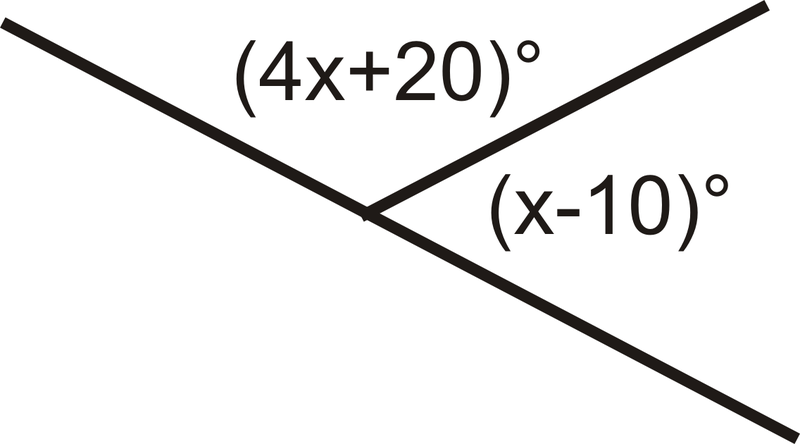 Figura\(\PageIndex{6}\)
Figura\(\PageIndex{6}\)
Encuentra la medida de un ángulo que forma un par lineal con\(\angle MRS\) if\(m \angle MRS\) is:
- \(61^{\circ}\)
- \(23^{\circ}\)
- \(114^{\circ}\)
- \(7^{\circ}\)
- \(179^{\circ}\)
- \(z^{\circ}\)
Reseña (Respuestas)
Para ver las respuestas de Revisar, abra este archivo PDF y busque la sección 1.9.
El vocabulario
| Término | Definición |
|---|---|
| Ángulos adyacentes | Dos ángulos son adyacentes si comparten un lado y un vértice. La palabra 'adyacente' significa 'al lado' o 'al lado de'. |
| par lineal | Dos ángulos forman un par lineal si son suplementarios y adyacentes. |
| Diagrama | Un diagrama es un dibujo utilizado para representar un problema matemático. |
Recursos adicionales
Elemento Interactivo
Video: Ángulos complementarios, suplementarios y verticales
Actividades: Preguntas de discusión sobre ángulos suplementarios
Ayudas de estudio: Guía de estudio de ángulos
Práctica: Ángulos suplementarios
Mundo real: Ángulos suplementarios

